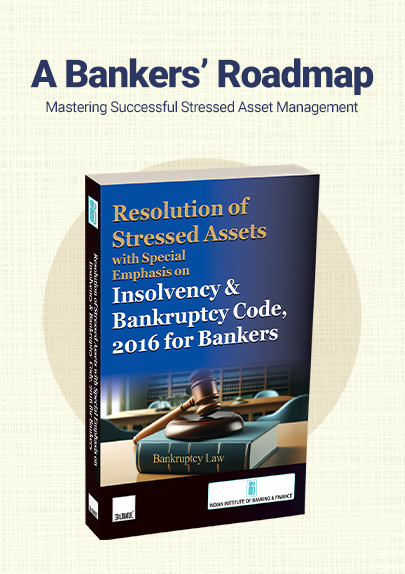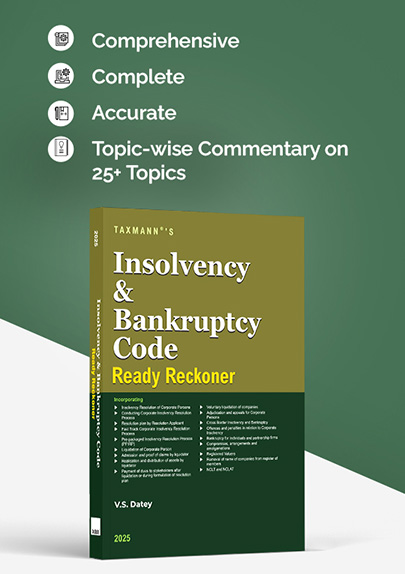In Absence of CIRP Against Principal Borrower, Application to Initiate Insolvency Against Personal Guarantor Lies Before DRT | NCLT
- Blog|News|Insolvency and Bankruptcy Code|
- 2 Min Read
- By Taxmann
- |
- Last Updated on 31 January, 2025
Case Details: Indian Bank v. Dharmesh Kumar Baid - [2025] 170 taxmann.com 659 (NCLT–Kolkata)
Judiciary and Counsel Details
- Smt. Bidisha Banerjee, Judicial Member & D. Arvind, Technical Member
-
Ms Zeba Khan & Ms Muskan Saha, Advs. for the Appellant.
-
Aman Kataruka, Adv. for the Respondent.
Facts of the Case
In the instant case, the Respondent/personal guarantor of the corporate debtor executed personal guarantee in favour of the financial creditor. The corporate debtor defaulted in repaying its debt. The financial creditor invoked personal guarantee and filed an instant petition under section 95 of the IBC against the respondent.
It was noted that in terms of Section 60 (1) and (2) read with Section 179 of IBC, the NCLT is only the Adjudicating Authority in respect of Personal Guarantors to a the Corporate Debtor where a corporate insolvency resolution process or liquidation proceeding initiated against a corporate debtor is either pending before a National Company Law Tribunal or is already concluded.
NCLT Held
The NCLT observed that, in the absence of an ‘initiated’ or ‘pending’ or ‘concluded’ CIRP against a principal borrower, an application under Section 95(1) of the IBC to initiate Insolvency Resolution Process against a personal guarantor to a corporate debtor will not be maintainable before the NCLT and appropriate proceedings will lie only before the Debt Recovery Tribunal (DRT) having territorial jurisdiction.
The NCLT held that since, no CIRP was ever initiated against the principal borrower, before the NCLT or any other Bench, the instant petition was not maintainable before the NCLT, and was to be dismissed.
List of Cases Reviewed
- State Bank of India v. Mahendra Kumar Jajodia in Company Appeal (AT) (Ins.) No. 60 of 2022 dated 27.01.2022 (Para 23)
- Axis Trustee Services Limited v. Brij Bhushan Singal reported in 2022 SCC OnLine Del 3634: (2022) 171 CLA 434 (Para 30) distinguished.
- Rohit Nath v. KEB Hana Bank Ltd. in C.R.P. (P.D.) No. 1289 of 2021 (Para 26)
- Embassy Property v. State of Karnataka reported in MANU/SC/1661/2019
- Shapoorji Pallonji Finance Pvt. Ltd. v. Rekha Singh in Company Appeal (AT) (Insolvency) No. 397 of 2022, 398 of 2022 and 399 of 2022, dated 18.01.2023 (Para 34) followed.
List of Cases Referred to
- Lalit Kumar Jain v. Union of India (2021) 9 SCC 321 (para 13).
Disclaimer: The content/information published on the website is only for general information of the user and shall not be construed as legal advice. While the Taxmann has exercised reasonable efforts to ensure the veracity of information/content published, Taxmann shall be under no liability in any manner whatsoever for incorrect information, if any.

Taxmann Publications has a dedicated in-house Research & Editorial Team. This team consists of a team of Chartered Accountants, Company Secretaries, and Lawyers. This team works under the guidance and supervision of editor-in-chief Mr Rakesh Bhargava.
The Research and Editorial Team is responsible for developing reliable and accurate content for the readers. The team follows the six-sigma approach to achieve the benchmark of zero error in its publications and research platforms. The team ensures that the following publication guidelines are thoroughly followed while developing the content:
- The statutory material is obtained only from the authorized and reliable sources
- All the latest developments in the judicial and legislative fields are covered
- Prepare the analytical write-ups on current, controversial, and important issues to help the readers to understand the concept and its implications
- Every content published by Taxmann is complete, accurate and lucid
- All evidence-based statements are supported with proper reference to Section, Circular No., Notification No. or citations
- The golden rules of grammar, style and consistency are thoroughly followed
- Font and size that’s easy to read and remain consistent across all imprint and digital publications are applied






 CA | CS | CMA
CA | CS | CMA


